Nursing: Strategies to Boost Immunization Coverage in Rural Areas
VerifiedAdded on 2023/06/11
|10
|2430
|277
Report
AI Summary
This report discusses strategies to improve vaccination uptake rates, focusing on patient education and reminder systems, particularly in rural areas. It highlights the importance of addressing vaccine hesitancy through education, providing reliable information, and using new media for reminders. The reflective paper included uses Rolfe's model to analyze the process of creating a poster to promote immunization, emphasizing the importance of understanding the target audience and planning appropriate delivery methods. The goal is to encourage behavioral change and support parents in overcoming barriers to immunization, ultimately improving vaccination coverage and promoting public health. Desklib provides this assignment solution and other resources for students.
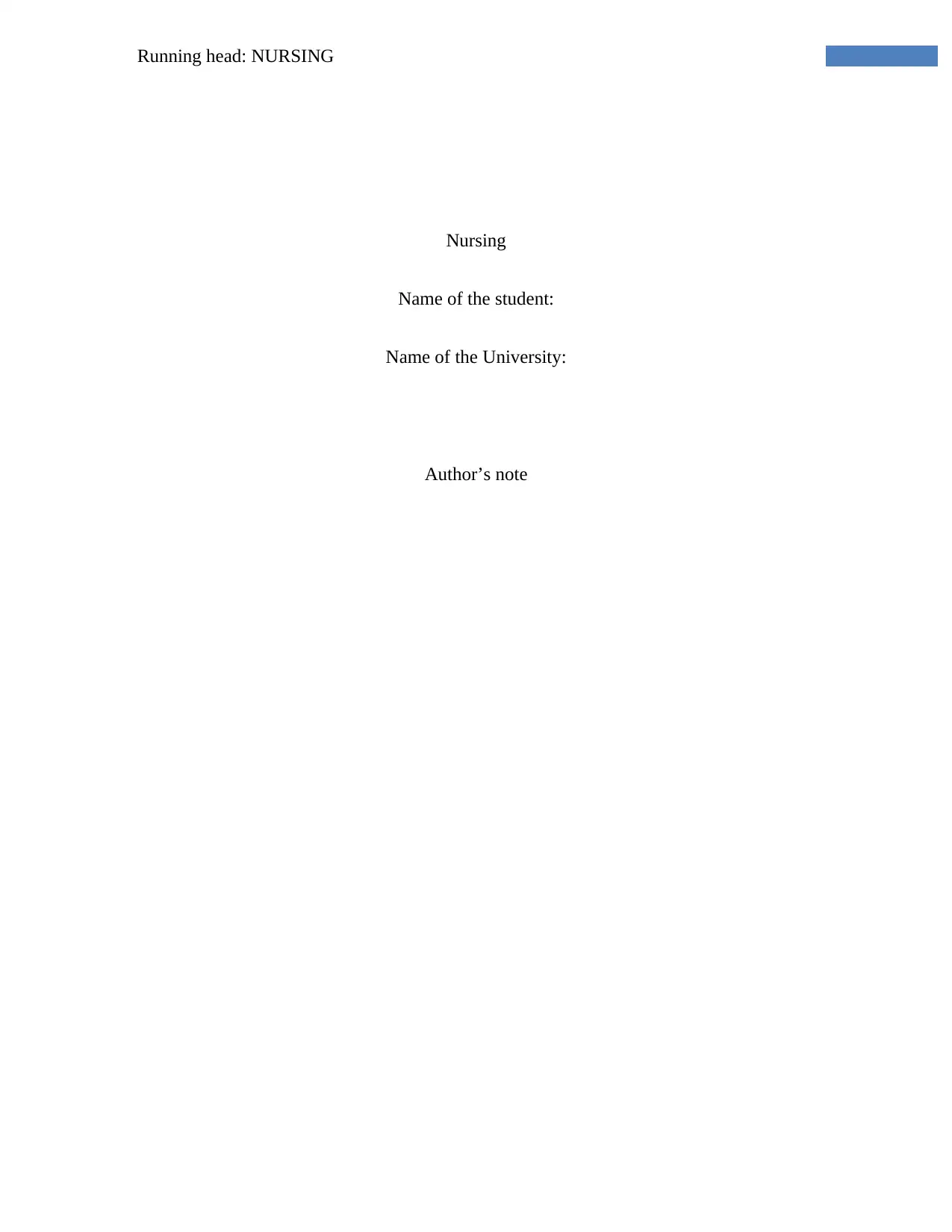
Running head: NURSING
Nursing
Name of the student:
Name of the University:
Author’s note
Nursing
Name of the student:
Name of the University:
Author’s note
Paraphrase This Document
Need a fresh take? Get an instant paraphrase of this document with our AI Paraphraser
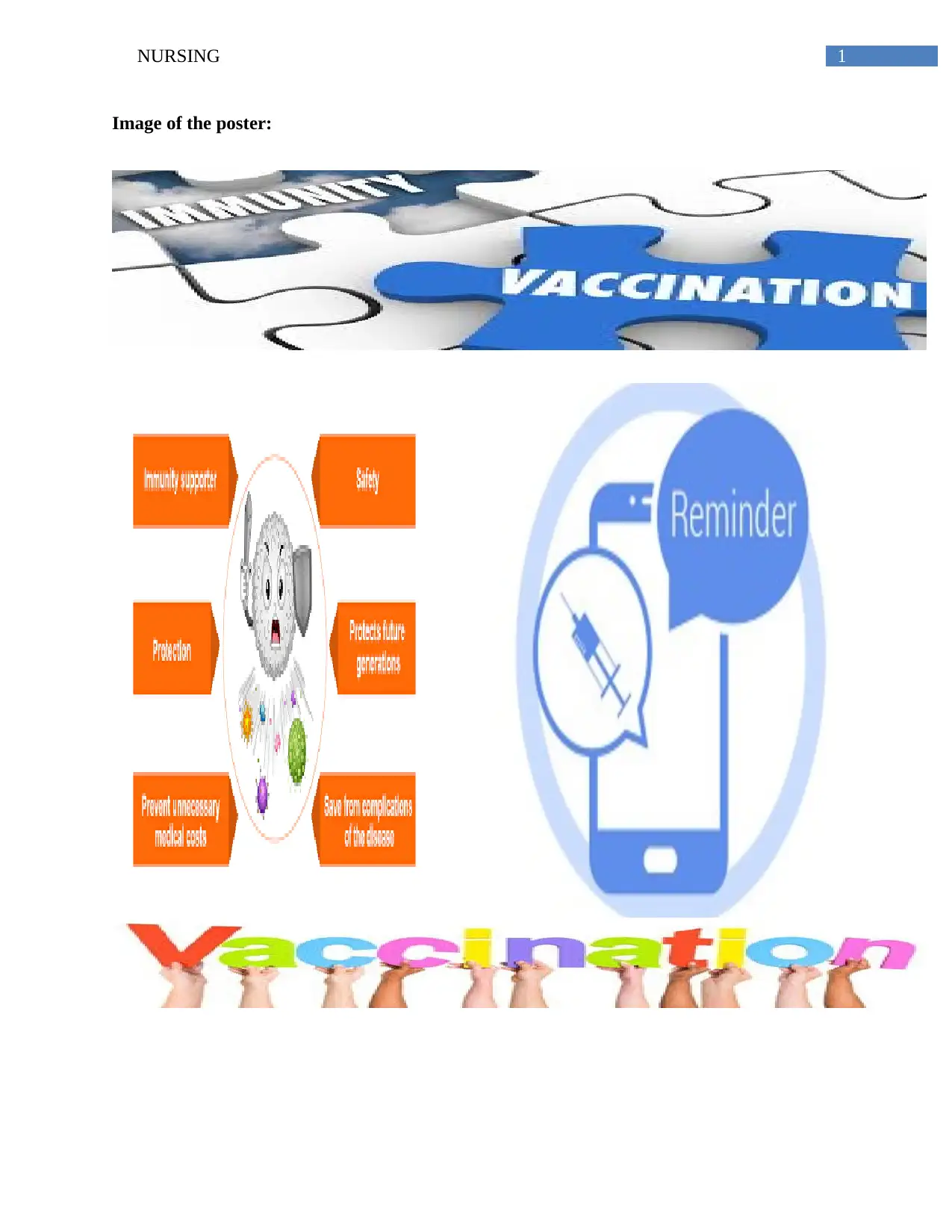
1NURSING
Image of the poster:
Image of the poster:
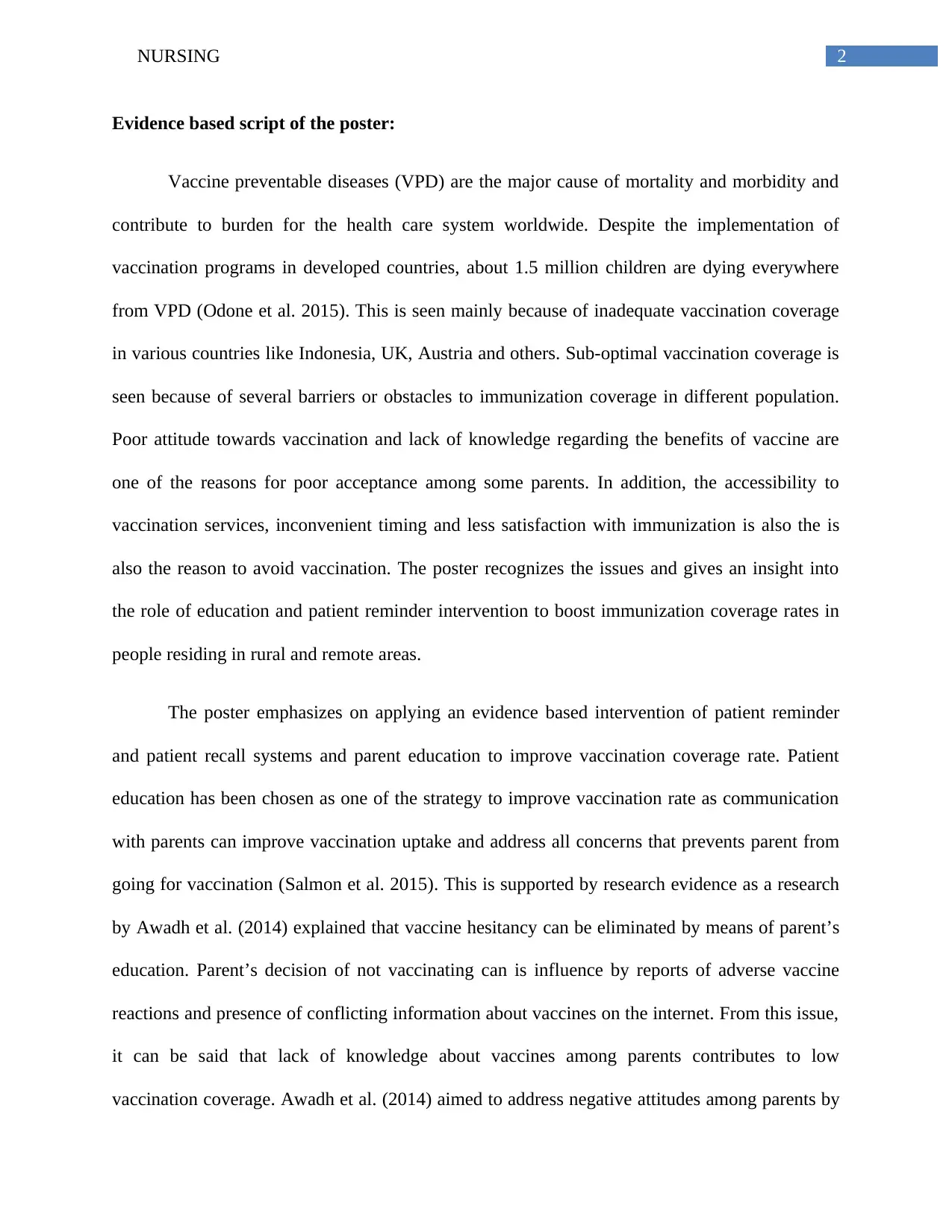
2NURSING
Evidence based script of the poster:
Vaccine preventable diseases (VPD) are the major cause of mortality and morbidity and
contribute to burden for the health care system worldwide. Despite the implementation of
vaccination programs in developed countries, about 1.5 million children are dying everywhere
from VPD (Odone et al. 2015). This is seen mainly because of inadequate vaccination coverage
in various countries like Indonesia, UK, Austria and others. Sub-optimal vaccination coverage is
seen because of several barriers or obstacles to immunization coverage in different population.
Poor attitude towards vaccination and lack of knowledge regarding the benefits of vaccine are
one of the reasons for poor acceptance among some parents. In addition, the accessibility to
vaccination services, inconvenient timing and less satisfaction with immunization is also the is
also the reason to avoid vaccination. The poster recognizes the issues and gives an insight into
the role of education and patient reminder intervention to boost immunization coverage rates in
people residing in rural and remote areas.
The poster emphasizes on applying an evidence based intervention of patient reminder
and patient recall systems and parent education to improve vaccination coverage rate. Patient
education has been chosen as one of the strategy to improve vaccination rate as communication
with parents can improve vaccination uptake and address all concerns that prevents parent from
going for vaccination (Salmon et al. 2015). This is supported by research evidence as a research
by Awadh et al. (2014) explained that vaccine hesitancy can be eliminated by means of parent’s
education. Parent’s decision of not vaccinating can is influence by reports of adverse vaccine
reactions and presence of conflicting information about vaccines on the internet. From this issue,
it can be said that lack of knowledge about vaccines among parents contributes to low
vaccination coverage. Awadh et al. (2014) aimed to address negative attitudes among parents by
Evidence based script of the poster:
Vaccine preventable diseases (VPD) are the major cause of mortality and morbidity and
contribute to burden for the health care system worldwide. Despite the implementation of
vaccination programs in developed countries, about 1.5 million children are dying everywhere
from VPD (Odone et al. 2015). This is seen mainly because of inadequate vaccination coverage
in various countries like Indonesia, UK, Austria and others. Sub-optimal vaccination coverage is
seen because of several barriers or obstacles to immunization coverage in different population.
Poor attitude towards vaccination and lack of knowledge regarding the benefits of vaccine are
one of the reasons for poor acceptance among some parents. In addition, the accessibility to
vaccination services, inconvenient timing and less satisfaction with immunization is also the is
also the reason to avoid vaccination. The poster recognizes the issues and gives an insight into
the role of education and patient reminder intervention to boost immunization coverage rates in
people residing in rural and remote areas.
The poster emphasizes on applying an evidence based intervention of patient reminder
and patient recall systems and parent education to improve vaccination coverage rate. Patient
education has been chosen as one of the strategy to improve vaccination rate as communication
with parents can improve vaccination uptake and address all concerns that prevents parent from
going for vaccination (Salmon et al. 2015). This is supported by research evidence as a research
by Awadh et al. (2014) explained that vaccine hesitancy can be eliminated by means of parent’s
education. Parent’s decision of not vaccinating can is influence by reports of adverse vaccine
reactions and presence of conflicting information about vaccines on the internet. From this issue,
it can be said that lack of knowledge about vaccines among parents contributes to low
vaccination coverage. Awadh et al. (2014) aimed to address negative attitudes among parents by
⊘ This is a preview!⊘
Do you want full access?
Subscribe today to unlock all pages.

Trusted by 1+ million students worldwide
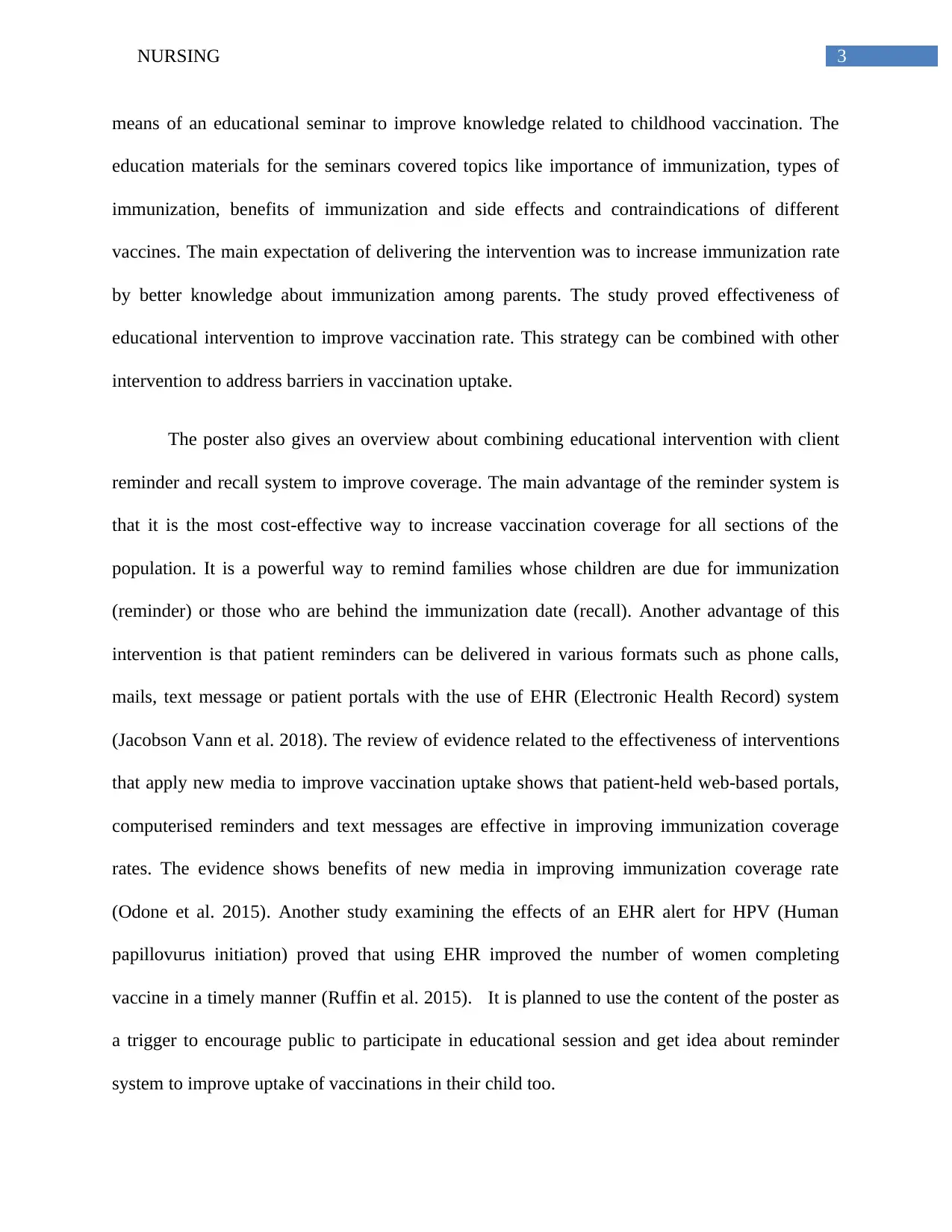
3NURSING
means of an educational seminar to improve knowledge related to childhood vaccination. The
education materials for the seminars covered topics like importance of immunization, types of
immunization, benefits of immunization and side effects and contraindications of different
vaccines. The main expectation of delivering the intervention was to increase immunization rate
by better knowledge about immunization among parents. The study proved effectiveness of
educational intervention to improve vaccination rate. This strategy can be combined with other
intervention to address barriers in vaccination uptake.
The poster also gives an overview about combining educational intervention with client
reminder and recall system to improve coverage. The main advantage of the reminder system is
that it is the most cost-effective way to increase vaccination coverage for all sections of the
population. It is a powerful way to remind families whose children are due for immunization
(reminder) or those who are behind the immunization date (recall). Another advantage of this
intervention is that patient reminders can be delivered in various formats such as phone calls,
mails, text message or patient portals with the use of EHR (Electronic Health Record) system
(Jacobson Vann et al. 2018). The review of evidence related to the effectiveness of interventions
that apply new media to improve vaccination uptake shows that patient-held web-based portals,
computerised reminders and text messages are effective in improving immunization coverage
rates. The evidence shows benefits of new media in improving immunization coverage rate
(Odone et al. 2015). Another study examining the effects of an EHR alert for HPV (Human
papillovurus initiation) proved that using EHR improved the number of women completing
vaccine in a timely manner (Ruffin et al. 2015). It is planned to use the content of the poster as
a trigger to encourage public to participate in educational session and get idea about reminder
system to improve uptake of vaccinations in their child too.
means of an educational seminar to improve knowledge related to childhood vaccination. The
education materials for the seminars covered topics like importance of immunization, types of
immunization, benefits of immunization and side effects and contraindications of different
vaccines. The main expectation of delivering the intervention was to increase immunization rate
by better knowledge about immunization among parents. The study proved effectiveness of
educational intervention to improve vaccination rate. This strategy can be combined with other
intervention to address barriers in vaccination uptake.
The poster also gives an overview about combining educational intervention with client
reminder and recall system to improve coverage. The main advantage of the reminder system is
that it is the most cost-effective way to increase vaccination coverage for all sections of the
population. It is a powerful way to remind families whose children are due for immunization
(reminder) or those who are behind the immunization date (recall). Another advantage of this
intervention is that patient reminders can be delivered in various formats such as phone calls,
mails, text message or patient portals with the use of EHR (Electronic Health Record) system
(Jacobson Vann et al. 2018). The review of evidence related to the effectiveness of interventions
that apply new media to improve vaccination uptake shows that patient-held web-based portals,
computerised reminders and text messages are effective in improving immunization coverage
rates. The evidence shows benefits of new media in improving immunization coverage rate
(Odone et al. 2015). Another study examining the effects of an EHR alert for HPV (Human
papillovurus initiation) proved that using EHR improved the number of women completing
vaccine in a timely manner (Ruffin et al. 2015). It is planned to use the content of the poster as
a trigger to encourage public to participate in educational session and get idea about reminder
system to improve uptake of vaccinations in their child too.
Paraphrase This Document
Need a fresh take? Get an instant paraphrase of this document with our AI Paraphraser
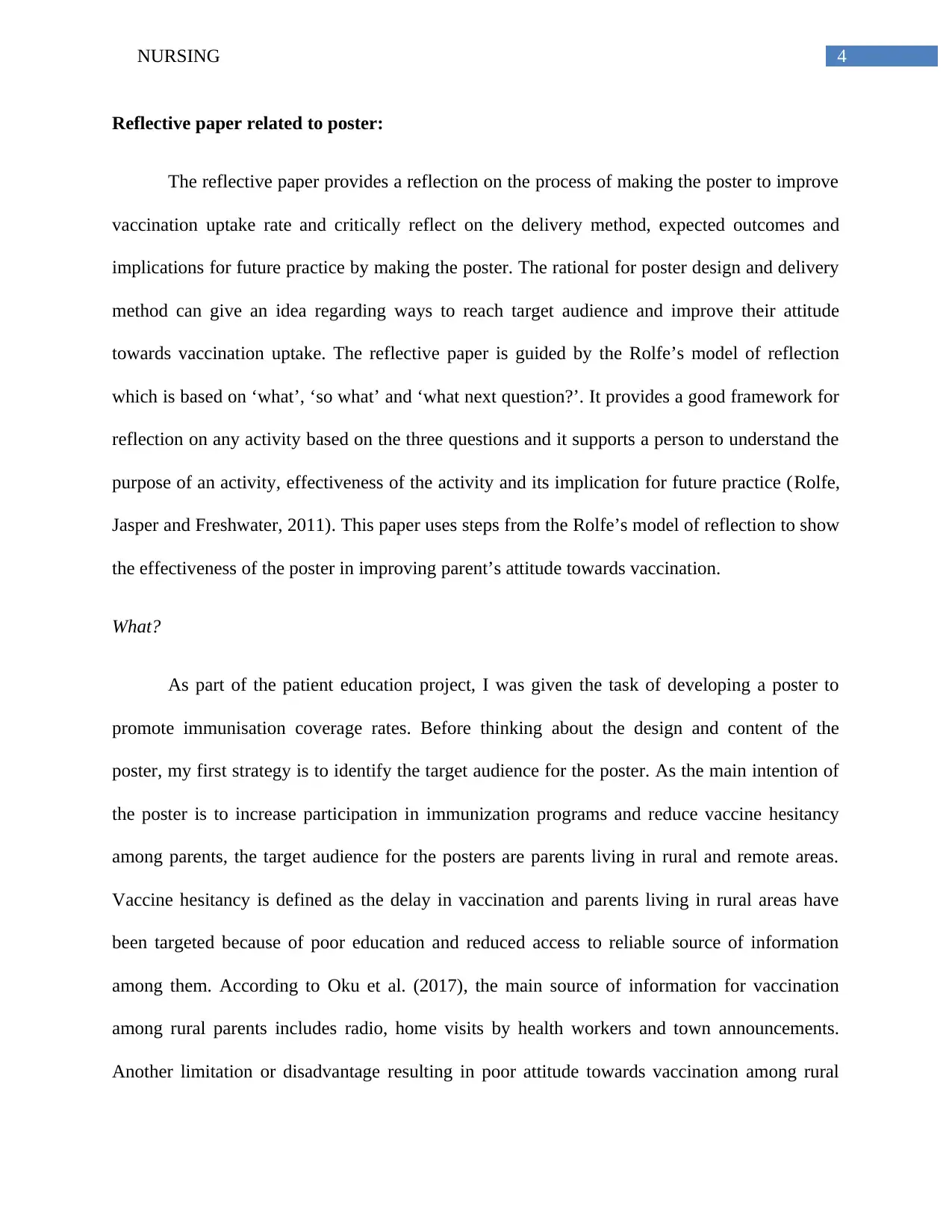
4NURSING
Reflective paper related to poster:
The reflective paper provides a reflection on the process of making the poster to improve
vaccination uptake rate and critically reflect on the delivery method, expected outcomes and
implications for future practice by making the poster. The rational for poster design and delivery
method can give an idea regarding ways to reach target audience and improve their attitude
towards vaccination uptake. The reflective paper is guided by the Rolfe’s model of reflection
which is based on ‘what’, ‘so what’ and ‘what next question?’. It provides a good framework for
reflection on any activity based on the three questions and it supports a person to understand the
purpose of an activity, effectiveness of the activity and its implication for future practice (Rolfe,
Jasper and Freshwater, 2011). This paper uses steps from the Rolfe’s model of reflection to show
the effectiveness of the poster in improving parent’s attitude towards vaccination.
What?
As part of the patient education project, I was given the task of developing a poster to
promote immunisation coverage rates. Before thinking about the design and content of the
poster, my first strategy is to identify the target audience for the poster. As the main intention of
the poster is to increase participation in immunization programs and reduce vaccine hesitancy
among parents, the target audience for the posters are parents living in rural and remote areas.
Vaccine hesitancy is defined as the delay in vaccination and parents living in rural areas have
been targeted because of poor education and reduced access to reliable source of information
among them. According to Oku et al. (2017), the main source of information for vaccination
among rural parents includes radio, home visits by health workers and town announcements.
Another limitation or disadvantage resulting in poor attitude towards vaccination among rural
Reflective paper related to poster:
The reflective paper provides a reflection on the process of making the poster to improve
vaccination uptake rate and critically reflect on the delivery method, expected outcomes and
implications for future practice by making the poster. The rational for poster design and delivery
method can give an idea regarding ways to reach target audience and improve their attitude
towards vaccination uptake. The reflective paper is guided by the Rolfe’s model of reflection
which is based on ‘what’, ‘so what’ and ‘what next question?’. It provides a good framework for
reflection on any activity based on the three questions and it supports a person to understand the
purpose of an activity, effectiveness of the activity and its implication for future practice (Rolfe,
Jasper and Freshwater, 2011). This paper uses steps from the Rolfe’s model of reflection to show
the effectiveness of the poster in improving parent’s attitude towards vaccination.
What?
As part of the patient education project, I was given the task of developing a poster to
promote immunisation coverage rates. Before thinking about the design and content of the
poster, my first strategy is to identify the target audience for the poster. As the main intention of
the poster is to increase participation in immunization programs and reduce vaccine hesitancy
among parents, the target audience for the posters are parents living in rural and remote areas.
Vaccine hesitancy is defined as the delay in vaccination and parents living in rural areas have
been targeted because of poor education and reduced access to reliable source of information
among them. According to Oku et al. (2017), the main source of information for vaccination
among rural parents includes radio, home visits by health workers and town announcements.
Another limitation or disadvantage resulting in poor attitude towards vaccination among rural
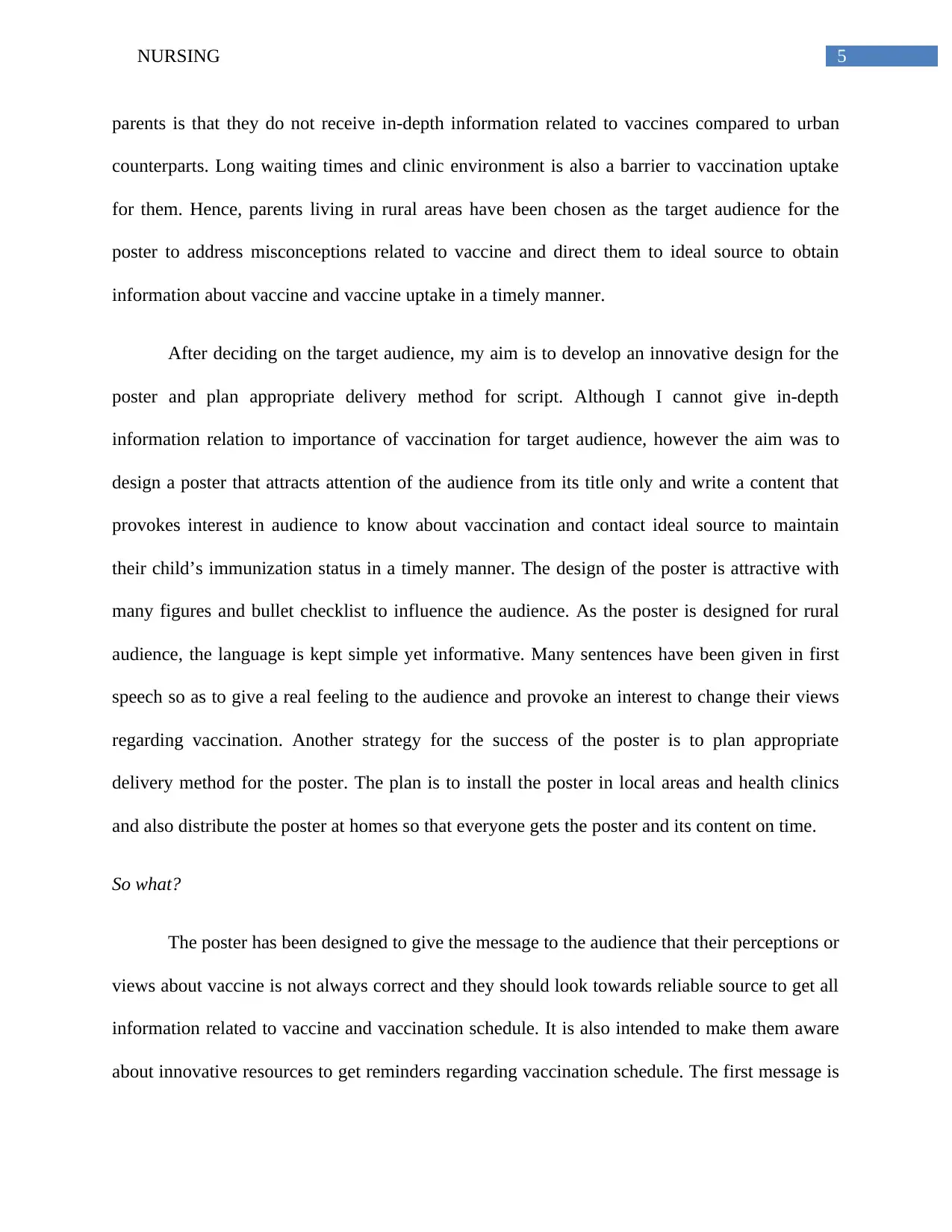
5NURSING
parents is that they do not receive in-depth information related to vaccines compared to urban
counterparts. Long waiting times and clinic environment is also a barrier to vaccination uptake
for them. Hence, parents living in rural areas have been chosen as the target audience for the
poster to address misconceptions related to vaccine and direct them to ideal source to obtain
information about vaccine and vaccine uptake in a timely manner.
After deciding on the target audience, my aim is to develop an innovative design for the
poster and plan appropriate delivery method for script. Although I cannot give in-depth
information relation to importance of vaccination for target audience, however the aim was to
design a poster that attracts attention of the audience from its title only and write a content that
provokes interest in audience to know about vaccination and contact ideal source to maintain
their child’s immunization status in a timely manner. The design of the poster is attractive with
many figures and bullet checklist to influence the audience. As the poster is designed for rural
audience, the language is kept simple yet informative. Many sentences have been given in first
speech so as to give a real feeling to the audience and provoke an interest to change their views
regarding vaccination. Another strategy for the success of the poster is to plan appropriate
delivery method for the poster. The plan is to install the poster in local areas and health clinics
and also distribute the poster at homes so that everyone gets the poster and its content on time.
So what?
The poster has been designed to give the message to the audience that their perceptions or
views about vaccine is not always correct and they should look towards reliable source to get all
information related to vaccine and vaccination schedule. It is also intended to make them aware
about innovative resources to get reminders regarding vaccination schedule. The first message is
parents is that they do not receive in-depth information related to vaccines compared to urban
counterparts. Long waiting times and clinic environment is also a barrier to vaccination uptake
for them. Hence, parents living in rural areas have been chosen as the target audience for the
poster to address misconceptions related to vaccine and direct them to ideal source to obtain
information about vaccine and vaccine uptake in a timely manner.
After deciding on the target audience, my aim is to develop an innovative design for the
poster and plan appropriate delivery method for script. Although I cannot give in-depth
information relation to importance of vaccination for target audience, however the aim was to
design a poster that attracts attention of the audience from its title only and write a content that
provokes interest in audience to know about vaccination and contact ideal source to maintain
their child’s immunization status in a timely manner. The design of the poster is attractive with
many figures and bullet checklist to influence the audience. As the poster is designed for rural
audience, the language is kept simple yet informative. Many sentences have been given in first
speech so as to give a real feeling to the audience and provoke an interest to change their views
regarding vaccination. Another strategy for the success of the poster is to plan appropriate
delivery method for the poster. The plan is to install the poster in local areas and health clinics
and also distribute the poster at homes so that everyone gets the poster and its content on time.
So what?
The poster has been designed to give the message to the audience that their perceptions or
views about vaccine is not always correct and they should look towards reliable source to get all
information related to vaccine and vaccination schedule. It is also intended to make them aware
about innovative resources to get reminders regarding vaccination schedule. The first message is
⊘ This is a preview!⊘
Do you want full access?
Subscribe today to unlock all pages.

Trusted by 1+ million students worldwide
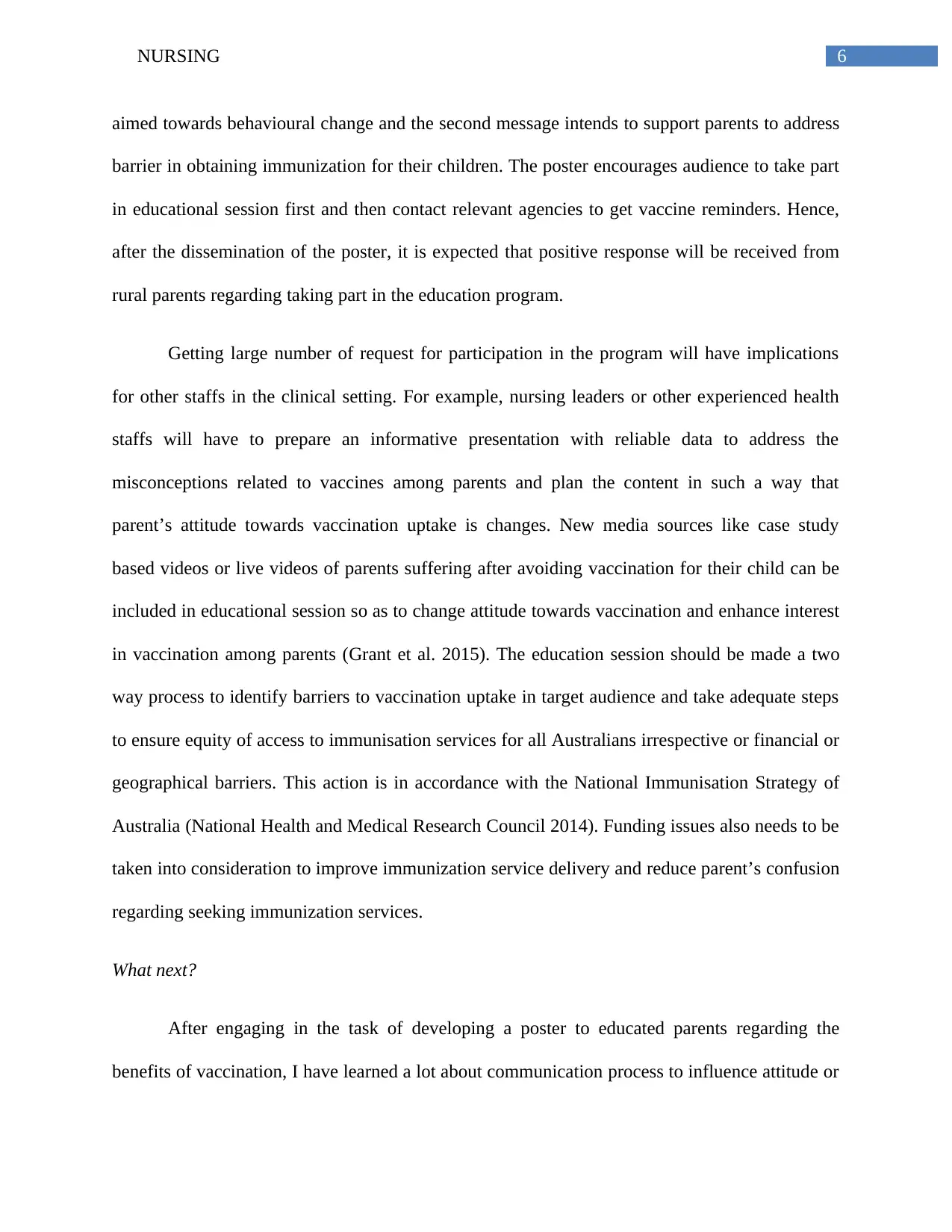
6NURSING
aimed towards behavioural change and the second message intends to support parents to address
barrier in obtaining immunization for their children. The poster encourages audience to take part
in educational session first and then contact relevant agencies to get vaccine reminders. Hence,
after the dissemination of the poster, it is expected that positive response will be received from
rural parents regarding taking part in the education program.
Getting large number of request for participation in the program will have implications
for other staffs in the clinical setting. For example, nursing leaders or other experienced health
staffs will have to prepare an informative presentation with reliable data to address the
misconceptions related to vaccines among parents and plan the content in such a way that
parent’s attitude towards vaccination uptake is changes. New media sources like case study
based videos or live videos of parents suffering after avoiding vaccination for their child can be
included in educational session so as to change attitude towards vaccination and enhance interest
in vaccination among parents (Grant et al. 2015). The education session should be made a two
way process to identify barriers to vaccination uptake in target audience and take adequate steps
to ensure equity of access to immunisation services for all Australians irrespective or financial or
geographical barriers. This action is in accordance with the National Immunisation Strategy of
Australia (National Health and Medical Research Council 2014). Funding issues also needs to be
taken into consideration to improve immunization service delivery and reduce parent’s confusion
regarding seeking immunization services.
What next?
After engaging in the task of developing a poster to educated parents regarding the
benefits of vaccination, I have learned a lot about communication process to influence attitude or
aimed towards behavioural change and the second message intends to support parents to address
barrier in obtaining immunization for their children. The poster encourages audience to take part
in educational session first and then contact relevant agencies to get vaccine reminders. Hence,
after the dissemination of the poster, it is expected that positive response will be received from
rural parents regarding taking part in the education program.
Getting large number of request for participation in the program will have implications
for other staffs in the clinical setting. For example, nursing leaders or other experienced health
staffs will have to prepare an informative presentation with reliable data to address the
misconceptions related to vaccines among parents and plan the content in such a way that
parent’s attitude towards vaccination uptake is changes. New media sources like case study
based videos or live videos of parents suffering after avoiding vaccination for their child can be
included in educational session so as to change attitude towards vaccination and enhance interest
in vaccination among parents (Grant et al. 2015). The education session should be made a two
way process to identify barriers to vaccination uptake in target audience and take adequate steps
to ensure equity of access to immunisation services for all Australians irrespective or financial or
geographical barriers. This action is in accordance with the National Immunisation Strategy of
Australia (National Health and Medical Research Council 2014). Funding issues also needs to be
taken into consideration to improve immunization service delivery and reduce parent’s confusion
regarding seeking immunization services.
What next?
After engaging in the task of developing a poster to educated parents regarding the
benefits of vaccination, I have learned a lot about communication process to influence attitude or
Paraphrase This Document
Need a fresh take? Get an instant paraphrase of this document with our AI Paraphraser
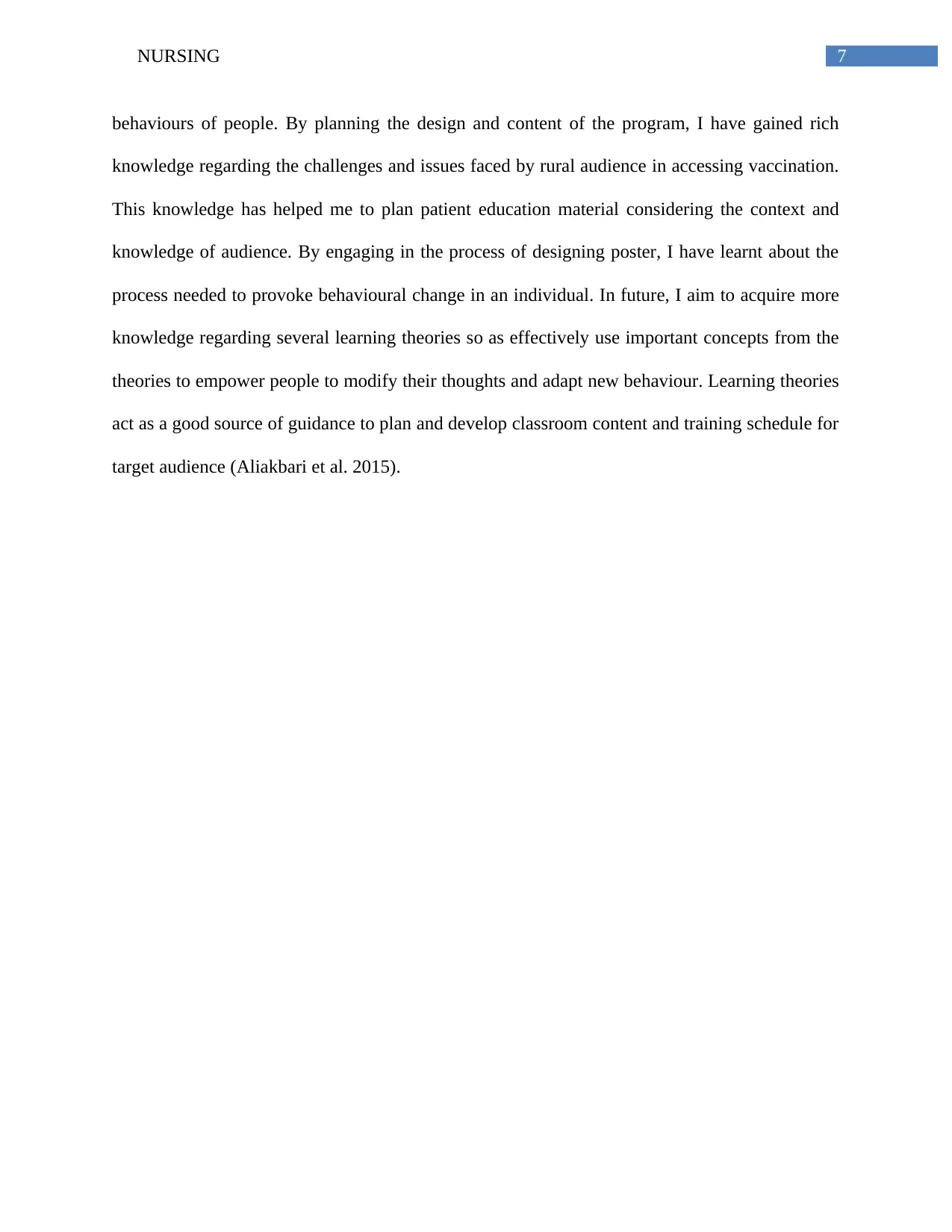
7NURSING
behaviours of people. By planning the design and content of the program, I have gained rich
knowledge regarding the challenges and issues faced by rural audience in accessing vaccination.
This knowledge has helped me to plan patient education material considering the context and
knowledge of audience. By engaging in the process of designing poster, I have learnt about the
process needed to provoke behavioural change in an individual. In future, I aim to acquire more
knowledge regarding several learning theories so as effectively use important concepts from the
theories to empower people to modify their thoughts and adapt new behaviour. Learning theories
act as a good source of guidance to plan and develop classroom content and training schedule for
target audience (Aliakbari et al. 2015).
behaviours of people. By planning the design and content of the program, I have gained rich
knowledge regarding the challenges and issues faced by rural audience in accessing vaccination.
This knowledge has helped me to plan patient education material considering the context and
knowledge of audience. By engaging in the process of designing poster, I have learnt about the
process needed to provoke behavioural change in an individual. In future, I aim to acquire more
knowledge regarding several learning theories so as effectively use important concepts from the
theories to empower people to modify their thoughts and adapt new behaviour. Learning theories
act as a good source of guidance to plan and develop classroom content and training schedule for
target audience (Aliakbari et al. 2015).
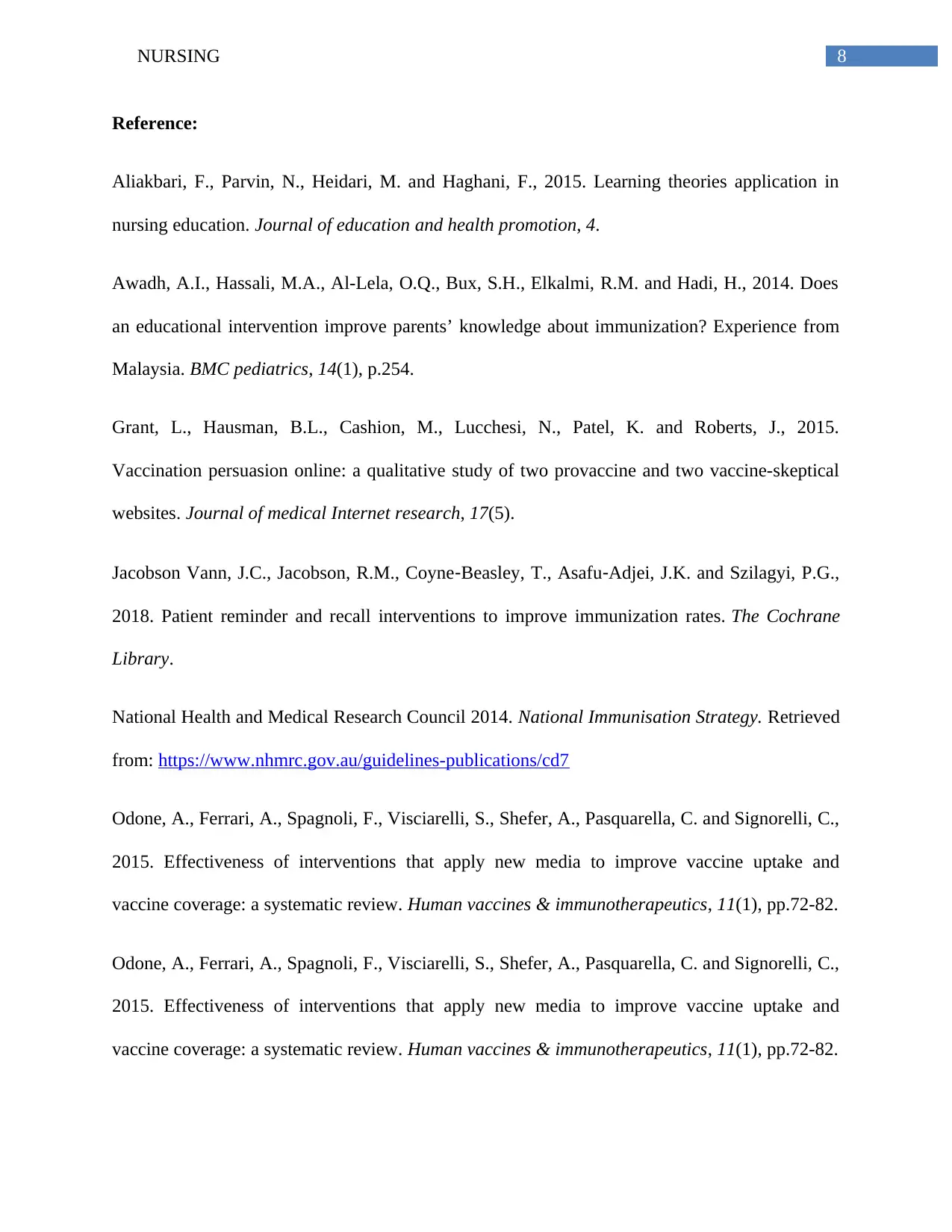
8NURSING
Reference:
Aliakbari, F., Parvin, N., Heidari, M. and Haghani, F., 2015. Learning theories application in
nursing education. Journal of education and health promotion, 4.
Awadh, A.I., Hassali, M.A., Al-Lela, O.Q., Bux, S.H., Elkalmi, R.M. and Hadi, H., 2014. Does
an educational intervention improve parents’ knowledge about immunization? Experience from
Malaysia. BMC pediatrics, 14(1), p.254.
Grant, L., Hausman, B.L., Cashion, M., Lucchesi, N., Patel, K. and Roberts, J., 2015.
Vaccination persuasion online: a qualitative study of two provaccine and two vaccine-skeptical
websites. Journal of medical Internet research, 17(5).
Jacobson Vann, J.C., Jacobson, R.M., Coyne‐Beasley, T., Asafu‐Adjei, J.K. and Szilagyi, P.G.,
2018. Patient reminder and recall interventions to improve immunization rates. The Cochrane
Library.
National Health and Medical Research Council 2014. National Immunisation Strategy. Retrieved
from: https://www.nhmrc.gov.au/guidelines-publications/cd7
Odone, A., Ferrari, A., Spagnoli, F., Visciarelli, S., Shefer, A., Pasquarella, C. and Signorelli, C.,
2015. Effectiveness of interventions that apply new media to improve vaccine uptake and
vaccine coverage: a systematic review. Human vaccines & immunotherapeutics, 11(1), pp.72-82.
Odone, A., Ferrari, A., Spagnoli, F., Visciarelli, S., Shefer, A., Pasquarella, C. and Signorelli, C.,
2015. Effectiveness of interventions that apply new media to improve vaccine uptake and
vaccine coverage: a systematic review. Human vaccines & immunotherapeutics, 11(1), pp.72-82.
Reference:
Aliakbari, F., Parvin, N., Heidari, M. and Haghani, F., 2015. Learning theories application in
nursing education. Journal of education and health promotion, 4.
Awadh, A.I., Hassali, M.A., Al-Lela, O.Q., Bux, S.H., Elkalmi, R.M. and Hadi, H., 2014. Does
an educational intervention improve parents’ knowledge about immunization? Experience from
Malaysia. BMC pediatrics, 14(1), p.254.
Grant, L., Hausman, B.L., Cashion, M., Lucchesi, N., Patel, K. and Roberts, J., 2015.
Vaccination persuasion online: a qualitative study of two provaccine and two vaccine-skeptical
websites. Journal of medical Internet research, 17(5).
Jacobson Vann, J.C., Jacobson, R.M., Coyne‐Beasley, T., Asafu‐Adjei, J.K. and Szilagyi, P.G.,
2018. Patient reminder and recall interventions to improve immunization rates. The Cochrane
Library.
National Health and Medical Research Council 2014. National Immunisation Strategy. Retrieved
from: https://www.nhmrc.gov.au/guidelines-publications/cd7
Odone, A., Ferrari, A., Spagnoli, F., Visciarelli, S., Shefer, A., Pasquarella, C. and Signorelli, C.,
2015. Effectiveness of interventions that apply new media to improve vaccine uptake and
vaccine coverage: a systematic review. Human vaccines & immunotherapeutics, 11(1), pp.72-82.
Odone, A., Ferrari, A., Spagnoli, F., Visciarelli, S., Shefer, A., Pasquarella, C. and Signorelli, C.,
2015. Effectiveness of interventions that apply new media to improve vaccine uptake and
vaccine coverage: a systematic review. Human vaccines & immunotherapeutics, 11(1), pp.72-82.
⊘ This is a preview!⊘
Do you want full access?
Subscribe today to unlock all pages.

Trusted by 1+ million students worldwide
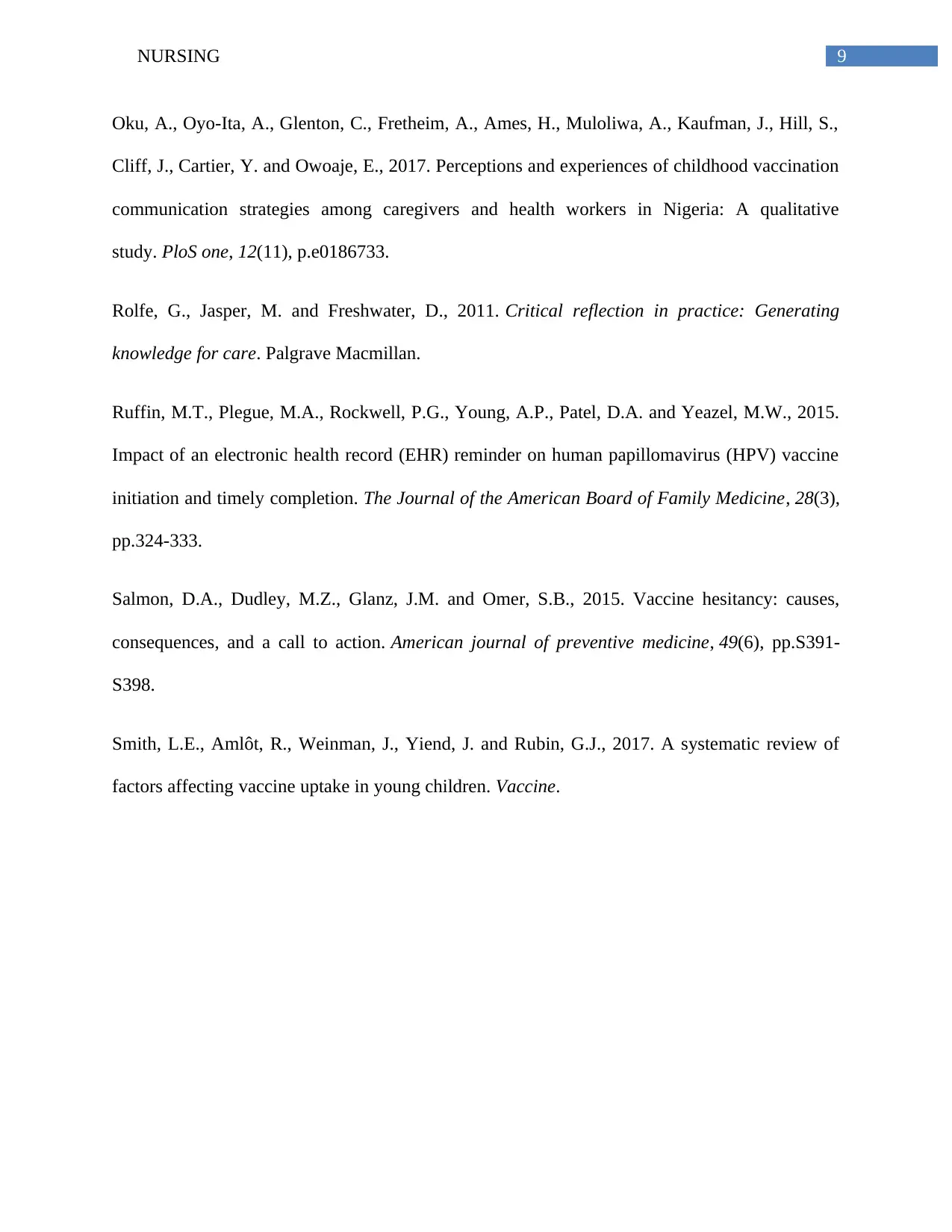
9NURSING
Oku, A., Oyo-Ita, A., Glenton, C., Fretheim, A., Ames, H., Muloliwa, A., Kaufman, J., Hill, S.,
Cliff, J., Cartier, Y. and Owoaje, E., 2017. Perceptions and experiences of childhood vaccination
communication strategies among caregivers and health workers in Nigeria: A qualitative
study. PloS one, 12(11), p.e0186733.
Rolfe, G., Jasper, M. and Freshwater, D., 2011. Critical reflection in practice: Generating
knowledge for care. Palgrave Macmillan.
Ruffin, M.T., Plegue, M.A., Rockwell, P.G., Young, A.P., Patel, D.A. and Yeazel, M.W., 2015.
Impact of an electronic health record (EHR) reminder on human papillomavirus (HPV) vaccine
initiation and timely completion. The Journal of the American Board of Family Medicine, 28(3),
pp.324-333.
Salmon, D.A., Dudley, M.Z., Glanz, J.M. and Omer, S.B., 2015. Vaccine hesitancy: causes,
consequences, and a call to action. American journal of preventive medicine, 49(6), pp.S391-
S398.
Smith, L.E., Amlôt, R., Weinman, J., Yiend, J. and Rubin, G.J., 2017. A systematic review of
factors affecting vaccine uptake in young children. Vaccine.
Oku, A., Oyo-Ita, A., Glenton, C., Fretheim, A., Ames, H., Muloliwa, A., Kaufman, J., Hill, S.,
Cliff, J., Cartier, Y. and Owoaje, E., 2017. Perceptions and experiences of childhood vaccination
communication strategies among caregivers and health workers in Nigeria: A qualitative
study. PloS one, 12(11), p.e0186733.
Rolfe, G., Jasper, M. and Freshwater, D., 2011. Critical reflection in practice: Generating
knowledge for care. Palgrave Macmillan.
Ruffin, M.T., Plegue, M.A., Rockwell, P.G., Young, A.P., Patel, D.A. and Yeazel, M.W., 2015.
Impact of an electronic health record (EHR) reminder on human papillomavirus (HPV) vaccine
initiation and timely completion. The Journal of the American Board of Family Medicine, 28(3),
pp.324-333.
Salmon, D.A., Dudley, M.Z., Glanz, J.M. and Omer, S.B., 2015. Vaccine hesitancy: causes,
consequences, and a call to action. American journal of preventive medicine, 49(6), pp.S391-
S398.
Smith, L.E., Amlôt, R., Weinman, J., Yiend, J. and Rubin, G.J., 2017. A systematic review of
factors affecting vaccine uptake in young children. Vaccine.
1 out of 10
Related Documents
Your All-in-One AI-Powered Toolkit for Academic Success.
+13062052269
info@desklib.com
Available 24*7 on WhatsApp / Email
![[object Object]](/_next/static/media/star-bottom.7253800d.svg)
Unlock your academic potential
Copyright © 2020–2025 A2Z Services. All Rights Reserved. Developed and managed by ZUCOL.





